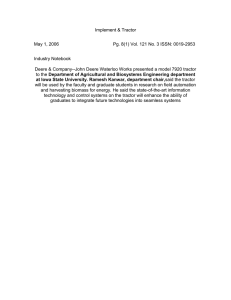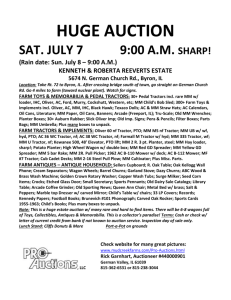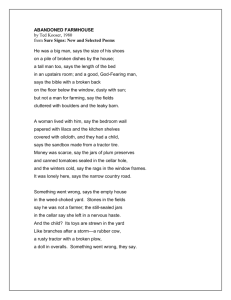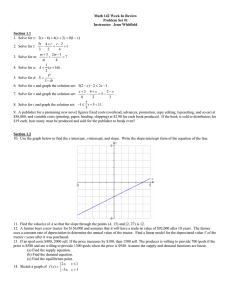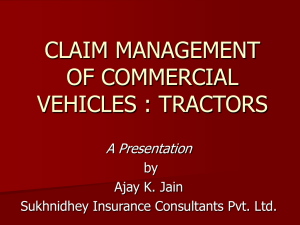Document 10949452
advertisement
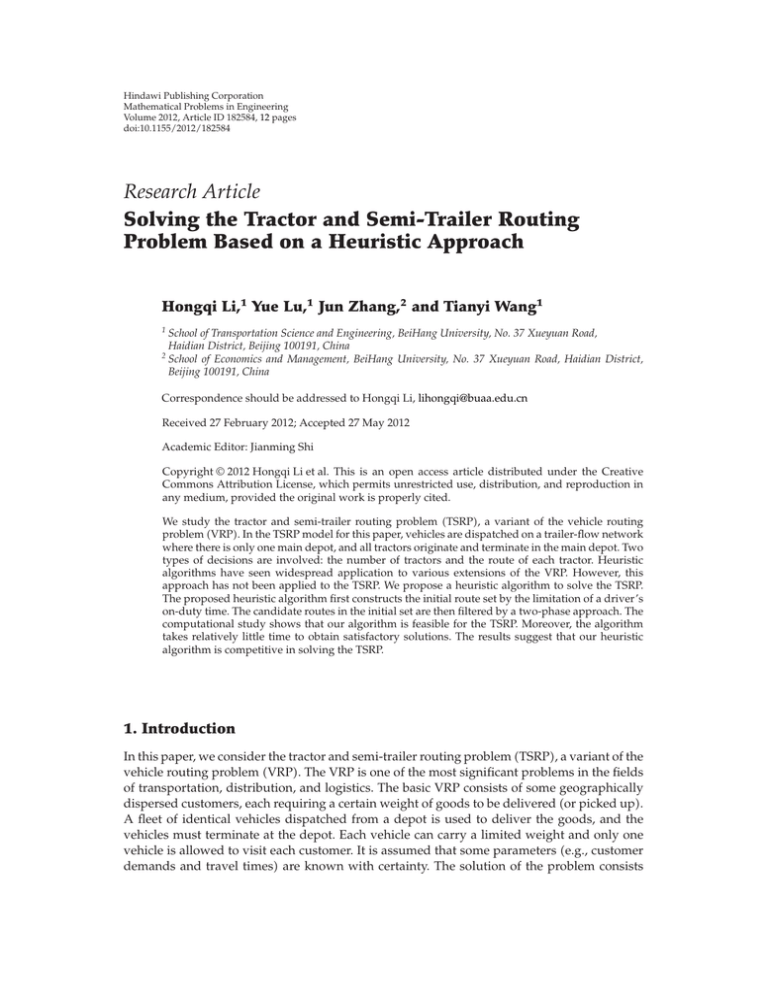
Hindawi Publishing Corporation
Mathematical Problems in Engineering
Volume 2012, Article ID 182584, 12 pages
doi:10.1155/2012/182584
Research Article
Solving the Tractor and Semi-Trailer Routing
Problem Based on a Heuristic Approach
Hongqi Li,1 Yue Lu,1 Jun Zhang,2 and Tianyi Wang1
1
School of Transportation Science and Engineering, BeiHang University, No. 37 Xueyuan Road,
Haidian District, Beijing 100191, China
2
School of Economics and Management, BeiHang University, No. 37 Xueyuan Road, Haidian District,
Beijing 100191, China
Correspondence should be addressed to Hongqi Li, lihongqi@buaa.edu.cn
Received 27 February 2012; Accepted 27 May 2012
Academic Editor: Jianming Shi
Copyright q 2012 Hongqi Li et al. This is an open access article distributed under the Creative
Commons Attribution License, which permits unrestricted use, distribution, and reproduction in
any medium, provided the original work is properly cited.
We study the tractor and semi-trailer routing problem TSRP, a variant of the vehicle routing
problem VRP. In the TSRP model for this paper, vehicles are dispatched on a trailer-flow network
where there is only one main depot, and all tractors originate and terminate in the main depot. Two
types of decisions are involved: the number of tractors and the route of each tractor. Heuristic
algorithms have seen widespread application to various extensions of the VRP. However, this
approach has not been applied to the TSRP. We propose a heuristic algorithm to solve the TSRP.
The proposed heuristic algorithm first constructs the initial route set by the limitation of a driver’s
on-duty time. The candidate routes in the initial set are then filtered by a two-phase approach. The
computational study shows that our algorithm is feasible for the TSRP. Moreover, the algorithm
takes relatively little time to obtain satisfactory solutions. The results suggest that our heuristic
algorithm is competitive in solving the TSRP.
1. Introduction
In this paper, we consider the tractor and semi-trailer routing problem TSRP, a variant of the
vehicle routing problem VRP. The VRP is one of the most significant problems in the fields
of transportation, distribution, and logistics. The basic VRP consists of some geographically
dispersed customers, each requiring a certain weight of goods to be delivered or picked up.
A fleet of identical vehicles dispatched from a depot is used to deliver the goods, and the
vehicles must terminate at the depot. Each vehicle can carry a limited weight and only one
vehicle is allowed to visit each customer. It is assumed that some parameters e.g., customer
demands and travel times are known with certainty. The solution of the problem consists
2
Mathematical Problems in Engineering
of finding a set of routes that satisfy the freight demand at minimal total cost. In practice,
additional operational requirements and restrictions, as in the case of the truck and trailer
routing problem TTRP, may be imposed on the VRP 1. The TTRP was first studied by
Semet and Taillard et al. 2 and Gerdessen 3 in the 1990s, and it was subsequently studied
by Chao 4, Scheuerer 5, and others. In the TTRP, the use of trailers a commonly neglected
feature in the VRP is considered. Some customers can be served by a combination vehicle
i.e., a truck pulling a trailer, as in type II in Figure 1, while other customers can only
be served by a truck as type I in Figure 1 due to some limitations such as government
regulations, limited maneuvering space at customer sites, road conditions, and so forth. These
constraints exist in many practical situations 1.
The VRP and its various extensions have long been one of the most studied
combinatorial optimization problems due to the problem’s complexity and extensive
applications in practice 6–10. The truck and trailer combination is employed widely by
enterprises around the world, but there additional features introduced by trailers that have
attracted some research. A number of studies have concentrated on applications of the TTRP.
For instance, Semet and Taillard et al. 2 and Caramia and Guerriero et al. 11 gave some
real-world TTRP applications in collection and delivery operations in rural areas or crowded
cities with accessibility constraints. Theoretically, being an extension of the VRP, the TTRP is
NP-Hard. The TTRP is computationally more difficult to solve than the VRP 1. Because the
VRP is usually tackled by heuristic methods 6–9, 12–15, it is feasible to develop heuristic
approaches for the TTRP.
Gerdessen 3 extended the VRP to the vehicle routing problem with trailers and
investigated the optimal deployment of a fleet of truck-trailer combinations by a construction
and improvement heuristic. Scheuerer 5 proposed construction heuristics called T-Cluster
and T-Sweep along with a tabu search algorithm for the TTRP. Tan et al. 16 proposed
a hybrid multiobjective evolutionary algorithm featuring specialized genetic operators,
variable-length representation; and local search heuristics to solve the TTRP. Lin et al. 1
proposed a simulated annealing SA heuristic for the TTRP and suggested that SA is
competitive with tabu search TS for solving the TTRP. Villegas et al. 17 solved the TTRP
by using a hybrid metaheuristic based on a greedy randomized adaptive search procedure
GRASP, variable neighborhood search VNS, and path relinking PR.
Villegas et al. 18 proposed two metaheuristics based on GRASP, VND, and
evolutionary local search ELS to solve the single truck and trailer routing problem with
satellite depots STTRPSD. Considering the number of available trucks and trailers to be
limited in the TTRP, Lin et al. 19 relaxed the fleet size constraint and developed a SA
heuristic for solving the relaxed truck and trailer routing problem RTTRP. Lin et al. 20
proposed a SA heuristic for solving the truck and trailer routing problem with time windows
TTRPTW.
Research to date has considered most types of road vehicles, especially trucks and
truck and trailer combinations. However, there has been little research on the types of tractor
and semi-trailer combinations. Hall and Sabnani et al. 21 studied routes that consisted of
two or more segments and two or more stops in the tour for a tractor. At each stop, the tractor
could drop off one or more trailers and pick up one or more trailers. Control rules based on
predicted route productivity were developed to determine when to release a tractor. Derigs et
al. 22 presented two approaches to solve the vehicle routing problem with multiple uses of
tractors and trailers. The primary objective was to minimize the number of required tractors.
Cheng et al. 23 proposed a model for a steel plant to find the tractor and semi-trailer
equipment and running routes for the purpose of minimizing transport distance. Liang 24
Mathematical Problems in Engineering
Truck
3
Truck
Trailer
I
II
Tractor
Tractor
Semi-trailer
III
Trailer
Semi-trailer
IV
Figure 1: The basic types of vehicles. Note: In practice, many vehicle types are used in road freight
transportation. This figure only lists four basic types. A large number of other types can be derived from
the four basic types by the number of axles, tires and the combination style. Enterprises in most of the
countries in the world employ various types.
established a dispatching model of tractors and semi-trailers in a large steel plant and used a
tabu search algorithm to find the optimal driving path and the cycle program.
We aim to propose a heuristic for the TSRP. This aim is based on the practical
knowledge that tractor and semi-trailer combinations are popular in some countries,
particularly China. The remainder of this paper is organized as follows. Section 2 compares
the TTRP and the TSRP and defines the TSRP. Section 3 proposes a heuristic algorithm to solve
the TSRP. Section 4 employs the heuristic algorithm to solve some experimental networks of
the TSR. Section 5 draws conclusions and gives future research directions.
2. Problem Definition
2.1. The TTRP and the TSRP
Although there is little literature devoted to the definition and solution of the TSRP in the
fields of transportation or logistics, plenty of research has been done on the TTRP, providing
important references for the TSRP. In the TTRP, a heterogeneous fleet composed of mtu trucks
and mtr trailers mtu > mtr serves a set of customers from a main depot. Each customer
has a certain demand, and the distances between any two points including customers and
depots are known. The capacities of the trucks and trailers are determinate. Some customers
must be served only by a truck, while other customers can be served either by a truck or
by a combination vehicle. The objective of the TTRP is to find a set of routes with minimum
total distance or cost so that each customer is visited in a route performed by a compatible
vehicle, the total demand of the customers visited on a route does not exceed the capacity of
the allocated vehicle, and the numbers of required trucks and trailers are not greater than mtu
and mtr , respectively 1, 17. There are three types of routes in a TTRP solution, as illustrated
in Figure 2: 1 a pure truck route traveled by a single truck; 2 a pure vehicle route without
any subtour traveled by a combination vehicle; 3 a combination vehicle route consisting of
a main tour traveled by a combination vehicle and at least one subtour traveled by the truck
alone.
The vehicle types in the TSRP are different from those in the TTRP. The TTRP focuses
on trucks and trailers, both of which can carry cargo. The TSRP involves mta tractors and
mst semi-trailers mta < mst . Although a tractor cannot carry cargo, it has more flexible
dispatching options, and it can pull different semi-trailers on various segments of its route
by the pick-up and drop-off operation at depots.
4
Mathematical Problems in Engineering
T4
C1 C2
T3
C1
T5
C2
C1 C2
C2
C2
C3
D
C
1
C4
D
C7
C6
C2 C4
C4 D
C7 D
C4 D
C4
C3 C4
C7
C3
C6
D
C5
C
5C
6
C5
T2
T1
D Depot
Loaded carriages of trucks
C1 , C2 , . . . , Cn Customers for combination vehicles visiting
T1 , T2 , . . . , Tn Customers for trucks visiting
Unloaded carriages of trucks
Figure 2: Different types of vehicle routes in the TTRP.
The TSRP can be formally defined on a directed graph G V, A, where V {0, 1, 2, . . . , n} is the set of vertices and A {i, j : i, j ∈ V } is the set of arcs. Each arc
i, j is generally associated with a transportation distance decided by road infrastructure.
The freight flow from i to j is regarded as certain weight of arc i, j. Vertex 0, . . . , v v < n
represents the main depots, in which many tractors and semi-trailers park. Some loaded
semi-trailers wait for visiting customers, and other unloaded semi-trailers wait for visiting
or maintenance. The remaining vertices si in V i.e., V \ {0, . . . , v} correspond to customers
who have m m ≥ 1 loaded semi-trailers waiting to visit l 1 ≤ l ≤ n and l ≤ m orientations
at the beginning of the simulation. Customers may have other unloaded semi-trailers waiting
for loading.
There are various tractor-driving modes on graph G during one daily period. For
example, 1 tractor Trj , pulling one loaded semi-trailer, goes from its main depot to a
customer in one-day period, and the customer has tractor-parking available; 2 tractor Trj ,
pulling one loaded semi-trailer, goes from its main depot to c1 . After the dropping and pulling
operations at c1 , the tractor goes on to another customer, c2 . The tractor Trj terminates at a
customer who has tractor-parking available. 3 It is similar to the running course listed in 2,
but Tractor Trj terminates at its main depot. The most basic elements of tractor-driving modes
include the following: how many semi-trailers can be pulled synchronously by a tractor, how
many vertexes are passed by the tractor, how many times per day the tractor can drop off one
or more trailers and pick up one or more trailers, whether a tractor terminates at its original
main depot, whether the semi-trailer pulled by a tractor loads cargo, and if a tractor runs
alone. In addition, a time window constraint is probably required.
Mathematical Problems in Engineering
5
The first selection
G01
G00
8
5
−
1
=
Four
7
5
4
1
1
4
6
G02
1
1
4
0
2
1
1
3
1
0
1
4
1
0
The second selection
G10
G12
G11
4
−
2
=
1
3
1
3
1
1
1
1
2
0
0
1
1
The third selection
G22
G21
G20
3
1
−
1
2
=
1
2
1
0
1
···
Figure 3: An example of selecting unit-flow networks. Note: Black points denote depots. Lines denote the
distribution of freight flows. Numbers near lines denote freight flow volume unit: one semi-trailer.
2.2. The TSRP Model
In practice, there are many depots on the freight transportation network of an enterprise.
Depots have different functions and sizes. In the TSRP, we classify these depots into two
types: main depots and customer depots. The flow of freight between any two depots is
usually uneven. In our method, we abstract the freight transportation network onto a graph
denoted by G00 . Graph G00 has one main depot and a number of customer depots where
semi-trailers can park. Initially, all tractors are parked in the main depot, and semi-trailers
that carry cargos are waiting for transport.
Because the freight flows among various depots are unequal, we select a freight flow
network denoted by G01 . G01 is a subset of G00 on which the freight flows among various
depots are equal. Graph G01 is probably a combination of some unit-flow network. On a unitflow network, the freight flow on every arc is one semi-trailer. We denote the subset G00 − G01
by G02 . We go on to select another equal flow network denoted by G11 from G02 . After
repeating this process several times, the original freight flow network is split into several
unit-flow networks e.g., G01 , G11 , and G21 in Figure 3. The study of unit-flow networks is
meaningful and important in solving the TSRP.
6
Mathematical Problems in Engineering
C9
C8
C3 D
C2
C6
C5
C3
C3
D
C2
C4
C1 C
2
C1
DC
1
C7
D Depot
C1 , C2 , . . . , Cn Customers
Loaded semi-trailers
Figure 4: Vehicle routes in the TSRP model.
The TSRP model in this paper uses the unit-flow network. Vertex 0 represents the main
depot where some loaded semi-trailers are waiting to be delivered to customers. The vertices
in V \ {0} correspond to customers who have m 1 ≤ m ≤ n loaded semi-trailers waiting for
going to m customers. The n customers have no parked tractors. The tractor-driving modes
must satisfy some constraints, including the following: tractors terminate at the main depot,
a tractor can pull one loaded semi-trailer and can also run alone, and the working time of a
tractor is decided by its driver team. All tractors or vehicles a vehicle is one tractor pulling
one semi-trailer originate and terminate at the main depot. Whenever a tractor passes by a
customer, the tractor picks up a semi-trailer. Whenever a vehicle passes by a customer, the
vehicle drops off its semi-trailer and picks up another one. After one-day period, the number
of semi-trailers parked in every customer point is not less than a minimum Figure 4.
The TSRP model consists of determining the number of tractors to be used and the
route of each tractor so that the variable costs and service level are balanced, while each
route starts and ends at the main depot. Variable costs are reduced by decreasing the overlap
distance of tractors running alone. The service level is based on the percentage of customer
demand that is satisfied.
3. A Heuristic Algorithm for the TSRP
3.1. Construct the Initial Solution Set
Drivers are assigned to ensure flexible running of tractors. A driver’s on-duty hours per
day are determined by the legal on-duty time and driver dispatching mode. On-duty
hours consist of driving hours plus temporary rest time or residence time in depots. The
residence time at the main depot denoted by H is for pick-up, drop-off, and some essential
maintenance work on vehicles. The temporary rest time at other depots denoted by si
i 1, 2, . . . is for pick-up and/or drop-off semi-trailers. The driving hours restrict tractor
running time.
Mathematical Problems in Engineering
7
The elements of the initial solution set are tractor routes. To give the form of a route,
we suggest the following procedure. The number of drivers assigned to each tractor is k. The
on-duty time of each driver is T hours per person · day. The distance between depots i and
j is dij . The depot sequence on each route is denoted by H − s1 − · · · − sf − H, which is the
form of a route. The same customer is visited only once on a certain tractor’s route, and each
si i 1, 2, . . . f is unique. The on-duty time T is a constraint on the route. That is,
ρ1 · kT ≤
i
j
dij
v
f · ts 2 · tH ≤ ρ2 · kT,
3.1
where ts and tH are the temporary rest time and the residence time, respectively. ρ1 0 < ρ1 <
1 and ρ2 1 ≤ ρ2 ≤ τ, τ is a limited number are the lower and upper limits of the utilization
ratio of the on-duty time, respectively. v is the average velocity of the tractor.
We suggest the steps below to construct elements of the initial solution set.
Step 1. Transform the distance matrix into a running time matrix. Use v as the parameter in
the transformation. Factors affecting v in practice include the tractor condition, the driver’s
skill, and traffic conditions. We estimate v by enterprise experience.
Step 2. Search the running time matrix. Let f be the sum of customers on a route. If f is very
large, there are too many customers on the route to allow too much temporary rest time.
Therefore, f has a maximum, and the maximum is certainly less than kT − 2 · tH /ts . Once
f is found, we implement an entire search on the running time matrix to find all routes that
satisfy the constraint 3.1.
Step 3. Compare the routes with freight flow demand. Every route in Step 2, which contains
many segments, is constructed by the segment running time of all customer pairs. In fact, not
all pairs of customers require freight exchange. There are segments on which no freight flows,
and tractors run alone on such segments. To save variable costs, the time of tractors running
alone is limited. Therefore, we obtain the initial solution set after the elimination of routes
based on the freight flow demand and the cost-saving requirement.
3.2. A 2-Phase Approach to Improve the Initial Solution Set
3.2.1. The First Phase
The more elements i.e., tractor routes in the initial solution set, the more choices for
freight enterprises. We classify tractor routes into certain types, according to the number of
customers on a route. There is one customer passed by in the 1st type, two customers passed
by in the 2nd type, and so on. When there are many customers on a route, the tractor can
serve more freight demand. When more temporary rest time is consumed at customer points,
the effective running hours of the tractor are reduced. Routes of the same type generally have
some “overlap arcs” in which only one tractor pulls a semi-trailer, and others run alone. We
suggest reducing the total distance of “overlap arcs.”
1 The first step is for the same type. An overlap arc i, j where the tractor running
time is less than a maximum tij max can be accepted. If the tractor needs more time
8
Mathematical Problems in Engineering
than tij max on arc i, j, only one of the routes containing arc i, j is permitted to
be chosen.
2 The second step is for different types. A “tractor route—overlap arc” matrix A0 ,
with elements aik is constructed. The rows of matrix A0 are serial numbers sni of
routes and the columns are various overlap arcs. The elements of matrix A0 are 1
or 0. If the element on row i and column k is “1”, then the sni route has an overlap
arc. When aik 1, any elements of the matrix that satisfy aij 1 are considered.
The column which contains aij has a sum i aij . If the route with serial number sni
is chosen, j i aij should be at a minimum. Once the sni route is chosen, other
routes that have the same overlap arcs with the sni route are eliminated from A0 .
Consequently, a row in A0 changes, and a new matrix A1 appears. The operation
is repeated until there is no row available in the last “tractor route—overlap arc”
matrix.
In the first phase, a transitional solution set that contains such elements as the sni
routes is constructed by improving the initial solution set.
3.2.2. The Second Phase
In the second phase, we propose the “fill-and-cut” approach to attain a satisfactory solution
to the TSRP.
Step 1. Construct a zero matrix O its elements are oij whose rows and columns are depots
i.e., the main depot and customer depots. Because of transportation demand, there are
freight flows between two particular depots. Because the segments of tractor routes in the
transitional solution set are defined by depots, we add 1 to oij when there is a route containing
arc i, j. We call such an operation a “fill”. By a “fill” operation, we mark all segments of
routes in the transitional solution set on matrix O. A new matrix B0 is thus formed.
Step 2. All route segments in the transitional solution set actually have corresponding
elements in matrix B0 . If a certain percentage e.g., 80∼100% of all corresponding elements of
the sni route are greater than 1, the sni route is eliminated. When the sni route is eliminated,
all of the corresponding elements subtract 1. We call such an operation a “cut”. Repeat the
“cut” operation, and a new matrix B1 finally forms. The routes corresponding to B1 make up
the satisfactory solution set.
In some cases, the number of nonzero elements of B1 is less than that of the freight flow
demands . Therefore, routes corresponding to B1 cannot satisfy all transportation demand. In
order to satisfy more customers’ demands , we can add some routes that contain overlap
arcs to increase the market adaptability of the satisfactory solution. However, too many
overlap arcs can exist because of uneven freight flows. Therefore, to balance the service level
and costs, meeting a certain percentage e.g., 80% of all transportation demand can be the
objective.
4. Computational Study
We abstract the transportation network on an N × N grid, where the nodes denote the main
depot and customer depots. In our computational study, the “RANDOM” function in Matlab,
Mathematical Problems in Engineering
9
Table 1: The tractor running time between two depots hours.
From
H
1
2
3
4
5
6
7
8
9
10
11
12
13
To
H
1
2
3
4
5
6
7
8
9
10
11
12
13
0
5.5
4.0
4.5
1.5
1.0
1.0
4.0
3.0
4.5
1.0
3.5
3.5
3.0
5.5
0
1.5
1.0
4.0
4.5
4.5
2.5
2.5
3.0
5.5
4.0
5.0
6.5
4.0
1.5
0
2.5
2.5
3.0
3.0
4.0
3.0
4.5
4.0
3.5
3.5
5.0
4.5
1.0
2.5
0
3.0
3.5
3.5
1.5
1.5
2.0
4.5
3.0
4.0
5.5
1.5
4.0
2.5
3.0
0
0.5
0.5
4.5
3.5
5.0
1.5
4.0
4.0
3.5
1.0
4.5
3.0
3.5
0.5
0
1.0
5.0
4.0
5.5
2.0
4.5
4.5
4.0
1.0
4.5
3.0
3.5
0.5
1.0
0
4.0
3.0
4.5
1.0
3.5
3.5
3.0
4.0
2.5
4.0
1.5
4.5
5.0
4.0
0
1.0
0.5
4.0
2.5
3.5
5.0
3.0
2.5
3.0
1.5
3.5
4.0
3.0
1.0
0
1.5
3.0
1.5
2.5
4.0
4.5
3.0
4.5
2.0
5.0
5.5
4.5
0.5
1.5
0
3.5
2.0
3.0
4.5
1.0
5.5
4.0
4.5
1.5
2.0
1.0
4.0
3.0
3.5
0
2.5
2.5
2.0
3.5
4.0
3.5
3.0
4.0
4.5
3.5
2.5
1.5
2.0
2.5
0
1.0
2.5
3.5
5.0
3.5
4.0
4.0
4.5
3.5
3.5
2.5
3.0
2.5
1.0
0
1.5
3.0
6.5
5.0
5.5
3.5
4.0
3.0
5.0
4.0
4.5
2.0
2.5
1.5
0
Table 2: The freight flow between two depots one semi-trailer.
From
H
1
2
3
4
5
6
7
8
9
10
11
12
13
a
b
H
1
2
3
4
5
6
To
7
8
9
10
11
12
13
b
a
1
1
0
0
0
0
0
0
1
1
0
1
1
0
1
0
0
0
1
1
0
0
0
0
0
0
0
0
1
1
0
1
0
1
1
1
0
1
0
1
0
1
1
1
0
0
0
0
1
0
0
0
1
0
1
0
1
0
0
0
0
0
0
0
1
1
0
0
0
1
1
0
0
0
0
0
0
0
0
0
1
0
0
0
1
0
1
0
1
0
0
0
0
0
1
1
0
1
1
0
0
0
1
0
0
0
1
0
0
0
0
1
1
0
1
1
0
1
1
1
0
0
0
0
0
0
1
0
1
0
0
0
1
1
1
1
0
0
1
0
1
0
0
1
0
0
0
1
0
0
0
0
0
0
1
1
0
1
1
1
0
0
0
0
0
1
1
0
0
1
1
1
1
1
1
1
1
1
1
1
1
1
1
0
1
0
0
0
0
0
0
0
1
0
0
0
“1” denotes that there is one semi-trailer flow between two depots.
“0” denotes that there is no freight flow.
which can generate random arrays from a specified distribution, is used. By RANDOM
“norm”,1,1,10,10, a random array is generated. We select the negative positions of the array
as nodes and the minimum position as the main depot. The distance between any two nodes
is calculated by the gaps of rows and columns. The “RANDOM” function in MATLAB is also
used to determine the freight flow between two depots. The network expressed by Table 1
and the flow expressed by Table 2 make up example No. 1. By the above generation method,
we produce some transportation networks that are used to test the heuristic algorithm.
10
Mathematical Problems in Engineering
Table 3: The satisfactory solution of the TSRP achieved by the heuristic algorithm.
Types of the routes
Form of route
Working time
needed by
routes hours
A tractor with two drivers. Two different
customer depots are passed by.
The route repeats once a day.
H—1—13—H
17
A tractor with two drivers. Three different
customer depots are passed by.
The route repeats once a day.
H—3—13—4—H; H—7—12—2—H;
H—9—2—8—H; H—11—4—3—H;
H—11—13—9—H; H—12—5—13—H
17.5
A tractor with two drivers. Four different
customer depots are passed by.
The route repeats once a day.
H—5—10—7—12—H;
H—8—9—2—10—H
17
A tractor with two drivers. Five different
customer depots are passed by.
The route repeats once a day.
H—2—8—6—10—5—H;
H—6—4—13—8—11—H;
H—6—5—3—12—11—H;
H—6—11—8—9—4—H;
H—10—8—2—1—5—H
17.5
A tractor with two drivers. Six different
customer depots are passed by.
The route repeats once a day.
H—6—5—4—8—9—11—H
17
A tractor with two drivers. Two different
customer depots are passed by.
The route repeats twice a day.
H—8—6—H—13—6—H
17.5
According to some enterprise experience, a driver’s on-duty time is 8.5 hours per
day. One or two drivers are assigned to a tractor. A tractor with two drivers can work
consecutively for no more than 17 hours in a 24-consecutive-hour period. The temporary
rest time in customer depots is 0.5 hour, and the residence time in H is 1 hour. By using the
approach mentioned in Section 3.1, we attain different types of tractor routes for the No. 1
example. There are 175 elements in the initial solution set. By using the 2-phase approach, we
attain the satisfactory solution of the No. 1 example Table 3. When the enterprise employs
tractor routes as the satisfactory solution, it can satisfy 80 percent of all transportation
demand. Sixteen tractors and thirty-two drivers are needed during a 24-consecutive-hour
period. The total running time of 16 tractors is 230 hours per day. In 15 percent of the total
running time, tractors run alone.
It is feasible to propose exact algorithms e.g., integer programming for the TSRP
when the initial solution set is constructed. We proposed a 0-1 integer programming for
the No. 1 example and attained the exact solution. The exact solution can satisfy 84
percent of all transportation demand. Sixteen tractors and thirty-two drivers are needed
during a 24-consecutive-hour period. In 10 percent of the total running time, tractors
run alone. We implemented the proposed heuristic algorithm using Matlab and the 0-1
integer programming with QS. Although the exact algorithm can attain a slightly better
solution, it requires more calculating time. For the No. 1 example, the solving time using
the heuristic algorithm was approximately 80 seconds while that for the exact algorithm was
approximately 2000 seconds. We suggest that the heuristic algorithm has an advantage for
solving the TSRP.
Mathematical Problems in Engineering
11
Table 4: The results of TSRP experiments achieved by the heuristic algorithm.
Transportation network
Number of
nodes
10
11
12
13
14
15
17
18
19
21
22
23
On the solution
Number of Fraction of demand
freight flows
satisfied %
54
60
66
72
78
84
96
102
108
120
126
132
65
85
89
92
89
71
89
81
86
74
71
86
Number of
tractors
Average time of tractors
running alone hours
Calculation
time
seconds
10
18
17
22
23
18
28
25
32
28
28
37
0.9
1.9
1.8
2.1
1.6
1.8
1.7
1.6
1.7
1.6
1.4
1.8
3
5
26
45
78
47
59
86
114
198
234
310
We have repeated the generation of random arrays over 50 times to obtain some typical
computational networks. The heuristic algorithm was employed on these networks. We ran
the experiments of this section on a computer with an AMD Athlontm X2 Dual-Core QL65 running at 2.10 GHz under Windows 7 ultimate 32 bits with 2 GB of RAM. Table 4
summarizes the characteristics of each solution in the 12-instance testbed.
5. Conclusions and Future Work
In this paper, we proposed a TSRP model and suggested a heuristic algorithm to solve it. The
TSRP concentrated on a unit-flow network, and all tractors originated and terminated at a
main depot. Unlike most approaches to the TTRP or VRP, the heuristic algorithm for the TSRP
did not regard the number of vehicles as a precondition. Therefore, the solution to the TSRP
was able to balance the variable costs and service level by altering the vehicle number. The
main characteristics of the heuristic algorithm are the initial solution set constructed by the
limitation of driver on-duty time and the combination of a two-phase filtration on candidate
routes. The computational study shows that our algorithm is feasible and effective for the
TSRP. Although some exact algorithms for the TSRP are feasible after the initial solution set
is constructed, the heuristic algorithm is efficient because it takes relatively less time to obtain
satisfactory solutions. Future research may try to extend the TSRP to include more practical
considerations, such as time window constraints. Other efficient heuristics for the TSRP may
also be proposed. In this regard, the benchmark instances generated in this study may serve
as a testbed for future research to test the efficiency of specific algorithms for TSRP.
Acknowledgments
This work was partially funded by the Science and Technology Plan of Transportation
of Shandong Province 2009R58 and the Fundamental Research Funds for the Central
Universities YWF-10-02-059. This support is gratefully acknowledged.
12
Mathematical Problems in Engineering
References
1 S. W. Lin, V. F. Yu, and S. Y. Chou, “Solving the truck and trailer routing problem based on a simulated
annealing heuristic,” Computers and Operations Research, vol. 36, no. 5, pp. 1683–1692, 2009.
2 F. Semet and E. Taillard, “Solving real-life vehicle routing problems efficiently using tabu search,”
Annals of Operations Research, vol. 41, no. 4, pp. 469–488, 1993.
3 J. C. Gerdessen, “Vehicle routing problem with trailers,” European Journal of Operational Research, vol.
93, no. 1, pp. 135–147, 1996.
4 I. M. Chao, “A tabu search method for the truck and trailer routing problem,” Computers and
Operations Research, vol. 29, no. 1, pp. 33–51, 2002.
5 S. Scheuerer, “A tabu search heuristic for the truck and trailer routing problem,” Computers and
Operations Research, vol. 33, no. 4, pp. 894–909, 2006.
6 J. Renaud and F. F. Boctor, “A sweep-based algorithm for the fleet size and mix vehicle routing
problem,” European Journal of Operational Research, vol. 140, no. 3, pp. 618–628, 2002.
7 H. C. Lau, M. Sim, and K. M. Teo, “Vehicle routing problem with time windows and a limited number
of vehicles,” European Journal of Operational Research, vol. 148, no. 3, pp. 559–569, 2003.
8 F. Li, B. Golden, and E. Wasil, “A record-to-record travel algorithm for solving the heterogeneous fleet
vehicle routing problem,” Computers and Operations Research, vol. 34, no. 9, pp. 2734–2742, 2007.
9 S. Liu, W. Huang, and H. Ma, “An effective genetic algorithm for the fleet size and mix vehicle routing
problems,” Transportation Research Part E, vol. 45, no. 3, pp. 434–445, 2009.
10 E. Cao and M. Lai, “The open vehicle routing problem with fuzzy demands,” Expert Systems with
Applications, vol. 37, no. 3, pp. 2405–2411, 2010.
11 M. Caramia and F. Guerriero, “A milk collection problem with incompatibility constraints,” Interfaces,
vol. 40, no. 2, pp. 130–143, 2010.
12 D. Pisinger and S. Ropke, “A general heuristic for vehicle routing problems,” Computers & Operations
Research, vol. 34, no. 8, pp. 2403–2435, 2007.
13 Y. Marinakis and M. Marinaki, “A hybrid multi-swarm particle swarm optimization algorithm for the
probabilistic traveling salesman problem,” Computers & Operations Research, vol. 37, no. 3, pp. 432–442,
2010.
14 A. Garcia-Najera and J. A. Bullinaria, “An improved multi-objective evolutionary algorithm for the
vehicle routing problem with time windows,” Computers & Operations Research, vol. 38, no. 1, pp.
287–300, 2011.
15 L. Hong, “An improved LNS algorithm for real-time vehicle routing problem with time windows,”
Computers and Operations Research, vol. 39, no. 2, pp. 151–163, 2012.
16 K. C. Tan, Y. H. Chew, and L. H. Lee, “A hybrid multi-objective evolutionary algorithm for solving
truck and trailer vehicle routing problems,” European Journal of Operational Research, vol. 172, no. 3,
pp. 855–885, 2006.
17 J. G. Villegas, C. Prins, C. Prodhon, A. L. Medaglia, and N. Velasco, “A GRASP with evolutionary
path relinking for the truck and trailer routing problem,” Computers and Operations Research, vol. 38,
no. 9, pp. 1319–1334, 2011.
18 J. G. Villegas, C. Prins, C. Prodhon, A. L. Medaglia, and N. Velasco, “GRASP/VND and multi-start
evolutionary local search for the single truck and trailer routing problem with satellite depots,”
Engineering Applications of Artificial Intelligence, vol. 23, pp. 780–794, 2010.
19 S. W. Lin, V. F. Yu, and S. Y. Chou, “A note on the truck and trailer routing problem,” Expert Systems
with Applications, vol. 37, no. 1, pp. 899–903, 2010.
20 S. W. Lin, V. F. Yu, and C. C. Lu, “A simulated annealing heuristic for the truck and trailer routing
problem with time windows,” Expert Systems with Applications, vol. 38, pp. 15244–15252, 2011.
21 R. W. Hall and V. C. Sabnani, “Control of vehicle dispatching on a cyclic route serving trucking
terminals,” Transportation Research Part A, vol. 36, no. 3, pp. 257–276, 2002.
22 U. Derigs, R. Kurowsky, and U. Vogel, “Solving a real-world vehicle routing problem with multiple
use of tractors and trailers and EU-regulations for drivers arising in air cargo road feeder services,”
European Journal of Operational Research, vol. 213, no. 1, pp. 309–319, 2011.
23 Y. R. Cheng, B. Liang, and M. H. Zhou, “Optimization for vehicle scheduling in iron and steel works
based on semi-trailer swap transport,” Journal of Central South University of Technology, vol. 17, no. 4,
pp. 873–879, 2010.
24 B. Liang, Research on semi-trailer loop swap transportation applied in large-scale iron and steel works [M.S.
thesis], Central South University, 2009.
Advances in
Operations Research
Hindawi Publishing Corporation
http://www.hindawi.com
Volume 2014
Advances in
Decision Sciences
Hindawi Publishing Corporation
http://www.hindawi.com
Volume 2014
Mathematical Problems
in Engineering
Hindawi Publishing Corporation
http://www.hindawi.com
Volume 2014
Journal of
Algebra
Hindawi Publishing Corporation
http://www.hindawi.com
Probability and Statistics
Volume 2014
The Scientific
World Journal
Hindawi Publishing Corporation
http://www.hindawi.com
Hindawi Publishing Corporation
http://www.hindawi.com
Volume 2014
International Journal of
Differential Equations
Hindawi Publishing Corporation
http://www.hindawi.com
Volume 2014
Volume 2014
Submit your manuscripts at
http://www.hindawi.com
International Journal of
Advances in
Combinatorics
Hindawi Publishing Corporation
http://www.hindawi.com
Mathematical Physics
Hindawi Publishing Corporation
http://www.hindawi.com
Volume 2014
Journal of
Complex Analysis
Hindawi Publishing Corporation
http://www.hindawi.com
Volume 2014
International
Journal of
Mathematics and
Mathematical
Sciences
Journal of
Hindawi Publishing Corporation
http://www.hindawi.com
Stochastic Analysis
Abstract and
Applied Analysis
Hindawi Publishing Corporation
http://www.hindawi.com
Hindawi Publishing Corporation
http://www.hindawi.com
International Journal of
Mathematics
Volume 2014
Volume 2014
Discrete Dynamics in
Nature and Society
Volume 2014
Volume 2014
Journal of
Journal of
Discrete Mathematics
Journal of
Volume 2014
Hindawi Publishing Corporation
http://www.hindawi.com
Applied Mathematics
Journal of
Function Spaces
Hindawi Publishing Corporation
http://www.hindawi.com
Volume 2014
Hindawi Publishing Corporation
http://www.hindawi.com
Volume 2014
Hindawi Publishing Corporation
http://www.hindawi.com
Volume 2014
Optimization
Hindawi Publishing Corporation
http://www.hindawi.com
Volume 2014
Hindawi Publishing Corporation
http://www.hindawi.com
Volume 2014

